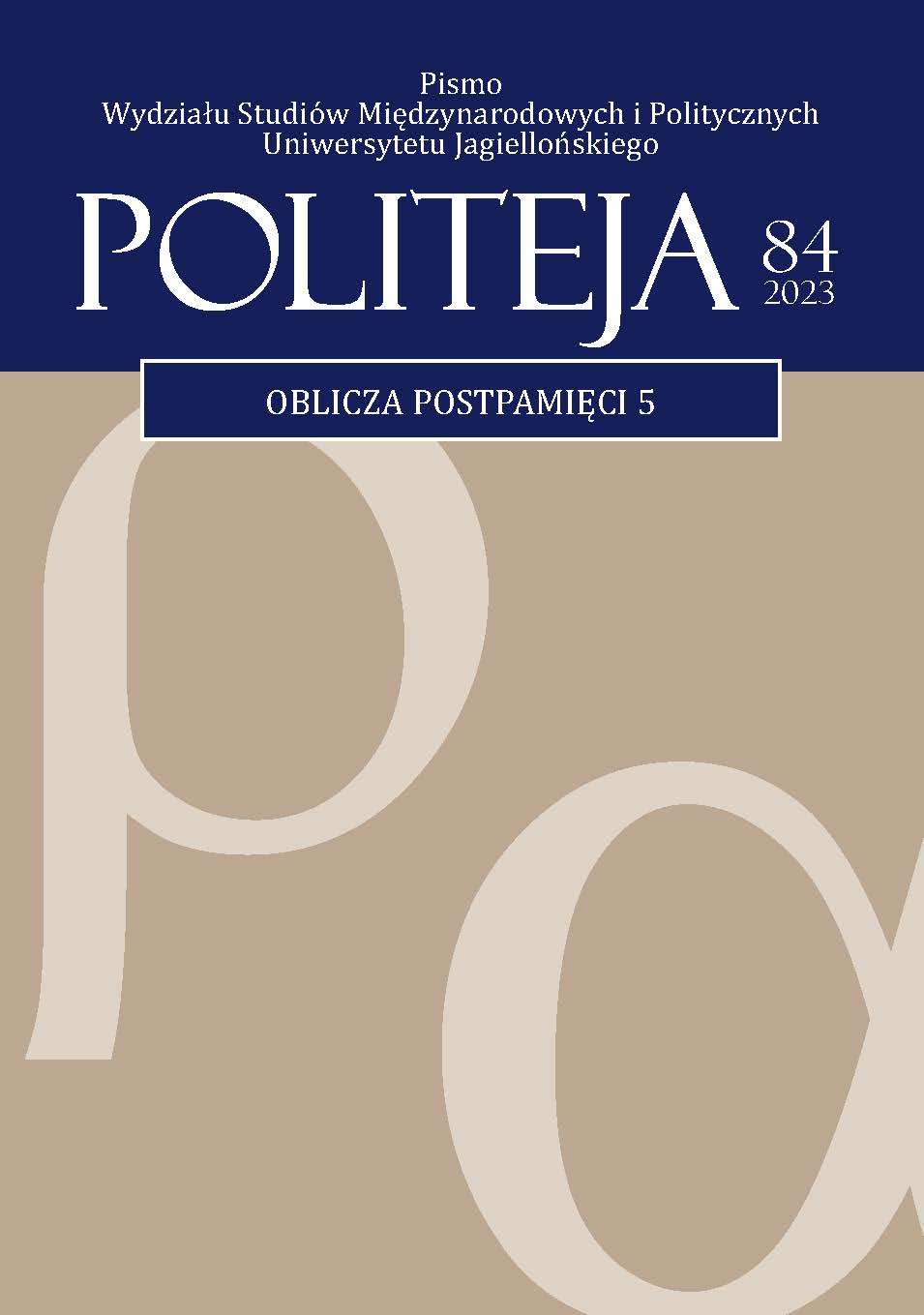(Post)pamięć konstruowana cyfrowo
Interaktywna biografia ocalałego – szanse i zagrożenia
DOI:
https://doi.org/10.12797/Politeja.20.2023.84.08Keywords:
technology, memory, testimony, second generation, interactivity, biographyAbstract
(POST)MEMORY DIGITALLY CONSTRUCTED: SURVIVORS’ INTERACTIVE BIOGRAPHY – OPPORTUNITIES AND THREATS
The purpose of the article is to provide a critical discussion of the USC Shoah Dimensions in Testimony project initiated and implemented by the USC Shoah Foundation. The article specifically focuses on the opportunities and threats presented by the ongoing dynamic development of the foundation’s project. Drawing on Marianne Hirsch’s concept of postmemory, which explores the spatial and temporal distance that separates successive generations from traumatic events, the article examines whether interactive biographies of survivors can be regarded as objects of postmemory that “preserve” (?) witnesses and their stories for future generations. In addition, the article analyzes how such virtual autobiographical identity narratives allow survivor to externalize their experience and transfer memory to the recipients of their testimonies. Ethical considerations regarding the “use” of near-holographic recordings of survivors are also discussed. Based on the collected research material, the article further explores how memory mediated by these objects affects the perception of past events.
Downloads
References
| 116 Cameras, [online] https://www.nytimes.com/video/opinion/100000005201010/116-cameras.html.
Alexander N., Obsolescence, Forgotten: „Survivor Holograms”, Virtual Reality, and the Future of Holocaust Commemoration, „Cinergie – Il cinema e le altre arti” 2021, vol. 19, s. 57-68.
Babwin D., New Tech, 3-D Holograms Preserve Holocaust Survivor Stories, AP News, 30 X 2017, [online:] https://apnews.com/article/446e1809b5b74e819b3f7efe80edcf45.
Baum R.N., Remediating the Body of the Witness: Holocaust Testimonies in New Media, paper presented at the International Conference on Bearing Witness More Than Once, Humboldt-Universität, Berlin, 16 III 2016, [w:] J. Shandler, Holocaust Memory in the Digital Age: Survivors’ Stories and New Media Practices, Stanford 2017, s. 171.
Billock J., An Exhibit in Illinois Allows Visitors to Talk with Holograms of 13 Holocaust Survivors, „Smithsonian Magazine” 2017, 1 XII, [online] https://www.smithsonianmag.com/travel/chat-holographic-holocaust-survivor-180967085/.
Braunstein A., At This Holocaust Museum, You Can Speak with Holograms of Survivors, „The Times of Israel” 2018, 27 I, [online] https://www.timesofisrael.com/at-this-holocaustmuseum-you-can-speak-with-holograms-of-survivors/.
Dimensions in Testimony, [online] https://sfi.usc.edu/dit.
Dimensions in Testimony: FAQs, [online] https://sfi.usc.edu/dit/faq.
Draaisma D., Machina metafor. Historia pamięci, przeł. R. Pucek, Warszawa 2009.
Fishbane M., Do Holocaust Survivors Dream of Electric Sheep?, „Tablet” 2020, 21 IV, [online] https://www.tabletmag.com/sections/arts-letters/articles/dimensions-in-testimonyholocaust-survivors.
Grau O., Virtual Art: From Illusion to Immersion, Cambridge–Londyn 2003, https://doi.org/10.7551/mitpress/7104.001.0001. DOI: https://doi.org/10.7551/mitpress/7104.001.0001
Hirsch M., Family Frames: Photography, Narrative and Postmemory, Cambridge–London 1997.
Hirsch M., Pokolenie postpamięci, przeł. M. Borowski, M. Sugiera, „Didaskalia. Gazeta Teatralna” 2011, vol. 18, nr 105.
Hirsch M., The Generation of Postmemory: Writing and Visual Culture after the Holocaust, New York 2012, https://doi.org/10.5749/minnesota/9780816674695.003.0009. DOI: https://doi.org/10.5749/minnesota/9780816674695.003.0009
Hirsch M., Żałoba i postpamięć, przeł. K. Bojarska, [w:] Teoria wiedzy o przeszłości na tle współczesnej humanistyki, red. E. Domańska, Poznań 2010.
Holocaust Survivors’ Stories Are Being Preserved with Holograms, „New York Post” 2019, 14 I, [online:] https://nypost.com/2019/01/14/holocaust-survivors-stories-are-being-preservedwith-holograms/.
Kansteiner W., The Holocaust in the 21st Century: Digital Anxiety, Transnational Cosmopolitan, and Never Again Genocide Without Memory, [w:] Digital Memory Studies: Media Pasts in Transition, red. A. Hoskins, New York–London 2018, s. 110-140, https://doi.org/10.4324/9781315637235-5. DOI: https://doi.org/10.4324/9781315637235-5
Katz L., Holograms of Holocaust Survivors Let Crucial Stories Live on, 11 II 2013, [online] https://www.cnet.com/news/holograms-of-holocaust-survivors-let-crucial-stories-live-on/.
Lumsden K., Kevin O’Neill Speaks: The Internet Afterlife, „Redlands Bulldog” 2016, 4 X, [online] https://www.theredlandsbulldog.com/kevin-oneill-speaks-the-internet-afterlife/.
McLuhan M., Przekazem jest środek przekazu, [w:] M. McLuhan, Zrozumieć media. Przedłużenia człowieka, przeł. N. Szczucka, Warszawa 2004, s. 39-53.
Migdal S., A New Dimension: Museum of Jewish Heritage Marks 20 Years with an Exhibit for the Ages, [online] https://www.thevillager.com/2017/09/a-new-dimension-museum-ofjewish-heritage-marks-20-years-with-an-exhibit-for-the-ages/.
New Dimensions in Testimony, [online:] https://ict.usc.edu/research/projects/new-dimen-sions-in-testimony/.
Papier S., „Hologram” ocalałego. Rozpoznanie, „Widok. Teorie i Praktyki Kultury Wizualnej” 2022, vol. 33. DOI: https://doi.org/10.36854/widok/2022.33.2559
Rehagen T., With Help from AI, a Holocaust Survivor’s Story Lives on, [online] https://expmag.com/2022/06/with-help-from-ai-a-holocaust-survivors-story-lives-on/.
Reich H., How to Talk to Holocaust Survivors in the Future? In Take a Stand’s Holograms, an Answer, „Chicago Tribune” 2017, 21 X, [online] https://www.chicagotribune.com/entertainment/music/howard-reich/ct-ae-holocaust-museum-center-1022-story.html.
Sadaj E., Interaktywne hologramy w Muzeum Holokaustu w Skokie. Świadectwa historii ocalone przez technologię przyszłości, „DEON. Portal Radia Deon” 2017, 3 XI, [online] https://deon24.com/interaktywne-hologramy-w-muzeum-holokaustu-w-skokie-swiadectwahistorii-ocalone-przez-technologie-przyszlosci/.
Shostak A.B., Stealth Althruism: Forbidden Care as Jewish Resistance in the Holocaust, Routledge, London–New York 2017, https://doi.org/10.4324/9781315114460. DOI: https://doi.org/10.4324/9781315114460
Sierzputowski K., Technologia: Pepper’s Ghost, [w:] Słuchając hologramu. Cielesność wirtualnych zespołów animowanych, Poznań 2018, s. 128.
Skalska T., Pamięć protetyczna, [w:] Modi memorandi. Leksykon kultur pamięci, red. M. Saryusz-Wolska, R. Traba, Warszawa 2014, s. 345.
Stahl L., Artificial Intelligence Preserving Our Ability to Converse with Holocaust Survivors Even After They Die, CBS News, 27 III 2022, [online] https://www.cbsnews.com/news/holocaust-stories-artificial-intelligence-60-minutes-2022-03-27/.
Stegmaier S., Ushakova S., The Production of German- and Russian-Language Interactive Biographies: (Trans)National Holocaust Memory between the Broadcast and Hyperconnective Agess, [w:] Digital Holocaust Memory, Education and Research, red. V.G. Walden, Switzerland AG 2021, https://doi.org/10.1007/978-3-030-83496-8_4. DOI: https://doi.org/10.1007/978-3-030-83496-8_4
Stroh P., How 3D Holograms and AI Are Preserving Holocaust Survivors’ Stories, CBC News, 26 I 2020, [online] https://www.cbc.ca/news/science/holocaust-survivor-hologram-1.5436430.
Tips and Guidelines for Engaging with Dimensions in Testimony, [online] https://assets.ctfassets.net/r2fjqekz37jz/4uQl99TO62sWKIcGL2Ro6v/873c0a573133da596885ccd30a2ab50c/Tips_and_Guidelines_for_Engaging_with_Dimensions_in_Testimony.pdf.
The interviewees, [online] https://sfi.usc.edu/dit/interviewees.
The Who, Where, Why and What about Dimensions in Testimony, [online] https://sfi.usc.edu/dit/faq.
USC Shoah Foundation Conducts Polish-language Dimensions in Testimony Interview with Marian Turski, [online] https://sfi.usc.edu/news/2022/08/33891-usc-shoah-foundation-conducts-polish-language-dimensions-testimony-interview.
Wiesel E., And the Sea Is Never Full: Memoirs, 1969-, przeł. M. Wiesel, New York 1999.
Zalewska M., Holography, Historical Indexicality, and the Holocaust, „Technologies of Knowing” 2016, Spectator 36 (1), s. 25-32.
Downloads
Published
Issue
Section
License

This work is licensed under a Creative Commons Attribution-NonCommercial-NoDerivatives 4.0 International License.






